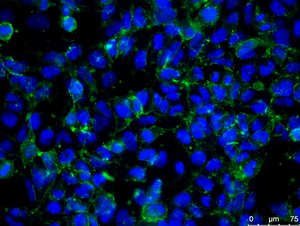First study showing improved drug levels in pediatric tumor microenvironment upon antibody-mediated nanoparticle release
This novel strategy took advantage of the overexpression of the tumor antigen GD2 in neuroblastoma. To allow for active drug targeting to this pediatric cancer, they chemically linked 3F8 (a clinical-grade anti-GD2 antibody developed by Nai-Kong V. Cheung –MSKCC-, coauthor of the study) on the surface of polymeric nanoparticles loaded with the potent anticancer drug SN-38. This study was strengthened by the use of patient-derived xenograft (PDX) models (mice with engrafted human tumors) developed at Sant Joan de Deu Hospital from patient biopsies. PDX are considered the gold-standard tumor model in recent drug discovery programs.
"The main novelty of our study was the approach to evaluate whether the antibody-mediated targeting of neuroblastoma was really active in a neuroblastoma PDX", said Angel Montero Carcaboso, researcher at Sant Joan de Déu and senior author of the study. "In my opinion there is a clear gap of technical resources in cancer nanomedicine studies. The accurate measurement of the drug delivered to the tumor over time is recognized by the drug agencies as the main challenge when evaluating nanomedicines. Upon systemic administration of a nanomedicine, the anticancer drug coexists in several fractions, mainly the nanoparticle-encapsulated fraction, and the released fraction, which is at the same time composed of protein-bound and free (unbound) fractions. However, it is likely that only the free drug will be the biologically active fraction once near the target cancer cell. With a microdialysis method we are able to collect samples from the tumor microenvironment, most specifically from the extracellular (interstitial) fluid. We applied this technique in our current study, providing definitive evidence of targeted prolonged delivery of free drug in the tumor due to conjugation of tumor-specific antibodies to nanoparticles carrying the drug".
The lead author of the study was Carles Monterrubio. "Thanks to our collaborator Alejandro Sosnik at Technion we developed and characterized the new nanoparticles and we even counted the number of antibodies conjugated on each particle: seven", Monterrubio said.
The research at Sant Joan de Déu was funded by the AECC Scientific Foundation, Fundacion BBVA, MINECO (SAF2011-22660 and PRI-AIBAR-2011-0977), European Union Seventh Framework Programme (FP7/2007-2013) under Marie Curie International Reintegration Grant (PIRG-08-GA-2010-276998) and ISCIII-FEDER (CP13/00189).
* Photograph: Neuroblastoma cells (blue) express the target of the nanoparticles: GD2 (green). Picture by Carles Monterrubio (Institut de Recerca Sant Joan de Déu).

